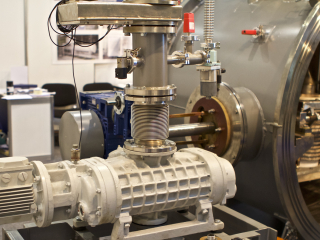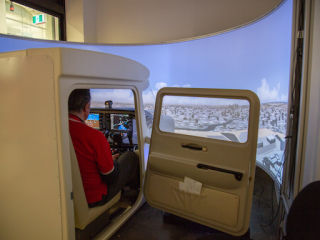3D Printing
UNSW has some of the most advanced 3D printed part production systems available on the market, facilitating work in metal, plastic, or ceramic. Our printers include a 3D Systems ProX DMP 300 and a ProJet 3500 HD MAX.
UNSW has some of the most advanced 3D printed part production systems available on the market, facilitating work in metal, plastic, or ceramic. Our printers include a 3D Systems ProX DMP 300 and a ProJet 3500 HD MAX.
A multidisciplinary research lab that harnesses the power of immersive technologies to explore complex topics through 3D computer animation, data visualisation and virtual reality (VR) immersive design.
The lab offers measurement and analysis of air-borne or structure-borne noise and vibration, and wear and fault analysis. It’s equipped with sound level meters, multi-channel signal analysers, shakers, sound sources, accelerometers, microphones and multi-functional tribometers.
Capabilities include biomedical fluid dynamics, with work relevant to arterial flows and haemodialysis, and the experimental area of laser fluid diagnostics. The lab has a four particle image velocimetry PIV) system and a Dantec three-component laser doppler anemometry (LDA) system.
The lab covers the processing of materials with lasers, laser-hybrids, water and air jets, mechanical machining, additive manufacturing, friction and wear.
Focuses on the aerodynamics of subsonic and supersonic flows. The lab allows for testing of aeroplane, ship, train, car and truck models, roof ventilators and wind turbines. It also calibrates instrumentation, such as anemometers and pressure measuring devices.
Based at Bankstown Airport, the facility provides remote sensing observation and analysis of airborne lidar and photogrammetry data. The fleet comprises a Diamond DA40 and Piper PA44 fitted with Garman G1000 flight navigation and display systems.
ANFF is a national network of open-access micro-and nano-fabrication labs. It is spread over 8 nodes, encompassing 20 universities and CSIRO, supported by 130 staff and maintains over 500 tools. ANFF-NSW focuses on developing devices and structures for quantum technologies, together with advanced electronics and photonics.
The lab contains Australia’s only automated fibre placement facility, along with material characterisation, design, analysis, lay-up and curing, and structural testing of large components with complex loading capabilities.
Contains a range of unmanned aerial vehicles and wheeled platforms for the development and testing of autonomous robotic systems.
Cross-disciplinary lab that hosts a range of human subject experiments exploring decision-making in business and economics. It contains 48 fixed touchscreen workstations, a 20-person negotiation table, a private observation area and instruments for bio-physiological measurement.
CIES operates several labs including:
A dedicated space for exploring collaborative city planning and user-centred design, CAL comprises a large decision support theatre, three virtual reality/augmented reality rooms, a Tangible Table sandbox and observation rooms.
Database providing search and discovery of high-quality urban, GIS and housing datasets for urban planners.
A sister facility to the National Facility for Human-Robot Interaction Research, the CRL advances human-machine interaction through the application of creative practice and the design of novel interfaces.
Contains multi-modal sensors to assess human performance in real-time using data sources such as EEG, voice, video, mouse movements, keyboard logging, and vibrations. It’s licensed to operate a suite of commercial software for personnel training and education.
Offers advanced simulation modelling, electrochemical analysis and battery test equipment, climate-controlled chambers and a 30kW/130kWh commercial VRB system.
The lab contains three sound-proofed engine test cells with a range of EC dynamometers, emission gas analysers, fuel injection rate meter and a single-cylinder small-bore diesel engine for performance tests.
The CPL encompasses performance and rehearsal spaces, costumes, sets, props, technical equipment, and expertise in all areas of production for live performance and screen arts.
The lab allows partners to solve real-world fire engineering challenges and includes an advanced automatic interactive cone calorimeter, a thermalgravimetric analyser, a vertical and horizontal flame spread test, limited oxygen index and microscale cone calorimeter.
The only research station in the arid zone of NSW, Fowlers Gap is located 112km north of Broken Hill. Some areas of the site have been continuously monitored for more than 30 years, providing a unique, long-term ecological record. The station carries out research on birds, kangaroos, reptiles, and other flora and fauna, along with management of the arid zone, soil conservation, solar energy, and astronomy.
Investigates the thermal and mechanical behaviour of metals, alloys, and metal-based composites. It enables physical simulation of industrial processes such as casting, extrusion, and forging; the systematic study of ambient-and-elevated-temperature material properties, including tensile strength, ductility, and creep; and exploration of fundamental phenomena such as solidification, recovery and recrystallisation, and precipitation reactions.

Equipment includes a high temperature carbon free hydrogen/vacuum furnace, 3D ceramic/metal printer (500W laser), hot isostatic press system AIP6-30H, spark plasma sintering (SPS) machine, radio frequency (RF) magnetron sputtering systems and the Gleeble 3500 Multifunctional Facility.
The university is an active member of NCI Australia - the nation’s most integrated, high-performance research computing environment.
The iCinema Centre develops AI-based immersive visualisations to model unpredictable scenarios. It facilitates the use of next-gen applications in contemporary art, cultural heritage, digital museology, mine training, environmental and transport simulations.
A large, netted area with a VICON motion capture system (MCS) allows indoor testing of drones and other robots, along with human motion studies and sensor calibrations. The MCS provides full 6-degrees-of-freedom (DOF) motion monitoring with sub-millimetre accuracy at up to 200Hz update rates.
An interdisciplinary initiative, the Innovation Hub brings together expertise from across the university to solve problems, respond to opportunities and facilitate positive change. Each year, the Hub undertakes a selection of projects proposed by students, staff, or partners.
Specialising in multi-scale manufacturing, cross-disciplinary characterisation of advanced materials, and solid mechanics, the lab is equipped with a 5-axis high precision turning centre, a 7-axis ultra-precision polishing centre, nanoindenter, nanotribometer, microtribometer, high temperature tribometer and an X-ray stress analyser and material property analyser.
The Centre is made up of 17 labs and facilities, supported by scientific and technical research staff. It allows for the structure and composition of biological, chemical, and physical materials to be studied. MWAC includes a consulting arm that offers a problem-solving service for commercial customers.
Dedicated to the structural testing and design of components and materials, lab capabilities include dynamic and quasistatic strength testing, fracture mechanics and fatigue crack growth testing, strain gauging, finite element stress analysis and testing of composite materials.
The lab has five robot manipulators equipped with vision systems, conveyor system and facilities to develop custom controllers. In addition, it offers mobile robotic platforms, two large-scale field vehicles with complete autonomous operational capability, four drones with 5kg payload and a helicopter with 10kg payload.
The MCIC Makerspace specialises in prototyping for startup ideas. It comprises wood, metal, and digital fabrication zones. The Centre also offers event and ideation spaces.
Conducts flow characterisation and temperature measurement on the micro-to-nano scale and includes an inverted epifluorescent microscope, microPIV system, Peltier cooled fluorescent camera, Nanosight LM14 with syringe pumps and various temperature and pressure sensors with data loggers.
Purpose-designed to host a variety of experiments investigating how people interact with technology devices, including robots.
The lab performs chemical characterisation of odours through olfactory-gas chromatography analysis, gas chromatography mass spectrometry, sulphur and nitrogen analysis, and olfactometry analysis. It also has specialist capability to undertake field sampling from area and point source emissions using both flux chamber and wind tunnels.
A test, calibration and research facility for light, colour, and optical testing. It is NATA accredited for ISO 17025.
The largest genomics facility at any Australian university, the centre is equipped with sequencing technology, expression analysis and high throughput microarray systems. It provides single cell genomic services, analysis of the microbiome, genome, and epigenome, and is NATA accredited to ISO/IEC 17025:2017.
A digital replica of our entire electricity grid and the only one of its kind in Australia, the digital twin allows for testing of new technologies, functions and operations in real time. Without it, trials would occur on the actual grid, causing delays and shutdowns.
Partners can access protein production, purification, and characterisation services, along with sample harvest and conditioning. The facility operates a quality management system and is accredited for ISO 9001:2015.
A state-of-the-art magnetic resonance imaging facility with support for collaborative projects. The facility comprises two 3T MRI systems: the Siemens Magnetom Vida and the Magnetom Prisma, in a purpose-designed space in the Prince of Wales Hospital.
The most advanced facility of its kind in Australia, this machine was tailor-made to fill the gap between fundamental research and high throughput manufacturing. It produces complex electronics on thin and flexible film and enables new types of manufacturing including circuits, sensors, supercapacitators, solar cells, energy storage and biomedical devices.
The school operates multiple labs including:
The industrial processing labs include 3D laser printing, hot isostatic pressing, spark plasma sintering, hot and cold rolling, thermomechanical processing, wire drawing, heat treatment, and casting equipment.
Located on the shore of Smiths Lake in the Myall Lakes National Park, the station conducts research into coastal and marine ecosystems.
Houses a range of solar collectors (flat plates, evacuated tubes and concentrating systems), temperature-controlled tanks, pumps, calibrated pyranometers, flow meters and data acquisition systems, for the conversion of solar energy into useful heat. The lab is used for prototyping new collector designs, materials and working fluids. It specialises in the modelling of heat pump systems, sizing of swimming pool heating systems and the development of direct absorption systems and latent energy storage systems.
The labs contain the latest surveying instruments and software for photogrammetry and remote sensing, precise and kinematic GNSS positioning and geospatial engineering. Equipment includes digital levels, GNSS receivers, RPAS and drones, lidar/laser scanners, and theodolites.
A collaboration between UNSW, University of Sydney, Macquarie University and UTS, SIMS infrastructure includes aquariums, research vessels, and labs for cell, molecular, microbiological, field biology and geological studies.
Equipment includes oxide and laser molecular beam epitaxy systems, scanning probe microscopy system, and radio frequency (RF) magnetron.

A world-first transport visualisation lab that enables multi-subject and multi-modal interaction in addition to remote international collaboration.
Conducts research and experiments on human-machine teaming. The lab is equipped with a continuous audio-video capture system, a variety of sensors and interaction devices, and a range of cognitive and data analysis software.
The only facility of its kind that allows for the study of blast waves at pressures up to 50MPa. The wave is generated by the spark from a high-powered, pulsed laser focused into the water.
Based on Sydney’s Northern Beaches, the WRL spans 4 hectares and is home to groundwater field and survey equipment, chemistry and soil labs, a centrifuge permeameter, UAV/drone surveying equipment, wave flumes, a spillway flume, and a wave basin.
The lab contains system design and test facilities including a microwave chamber, spectrum analysers, vector signal generators, FPGA development platforms, and software-defined radio platforms.